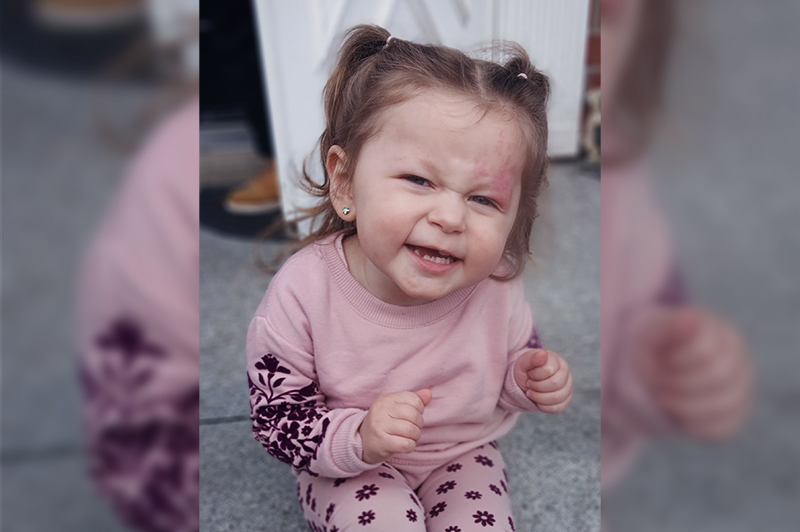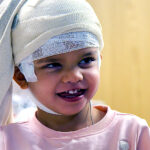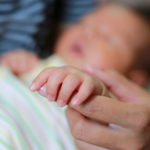Helping Jasmine manage Sturge-Weber syndrome before symptoms start

Sturge-Weber syndrome is a rare neurovascular disorder that increases the risk of seizures in infants due to abnormal blood vessel development in the brain. Almost 90 percent of children with Sturge-Weber experience their first seizure before age 2, which makes proactive, seizure-preventive care important in minimizing the risk of long-term brain injury. Finding such care, however, can be challenging. This is why Danielle, a mother of three, is so grateful for the care her youngest child, Jasmine, receives at the Sturge-Weber Clinic at Boston Children’s Hospital.
“I wholeheartedly believe that if Jasmine wasn’t being treated preventively by Boston Children’s, that she wouldn’t be who she is right now,” Danielle says of Jasmine, now 2 and a half.
A ‘bruise’ worth checking out
None of Danielle’s prenatal tests or ultrasounds showed anything unusual during her pregnancy. So, when Jasmine was born, Danielle thought the large mark above her eye was bruising from the difficult delivery. But when the bruising didn’t change, Danielle suspected it was something more serious. It was a nurse from her delivery hospital who encouraged Danielle to have Jasmine examined. Her mark — a port-wine stain — is a common indicator of Sturge-Weber syndrome.
“She told me to get her checked out for Sturge-Weber just to err on the side of caution,” Danielle says. “Everything I read about it scared me — the potential for seizures, stroke, glaucoma, and motor skill and developmental delays. My heart sank.”
Jasmine’s going to have a better quality of life because of the care she’s received at Boston Children’s”
Danielle contacted Dr. Rebecca Locke, her older children’s pediatrician at Children’s Hospital Primary Care Center (CHPCC) for guidance. Dr. Locke referred Jasmine to Dr. Anna Pinto, director of Boston Children’s Sturge-Weber Clinic. At the clinic, Dr. Pinto ordered an MRI to examine Jasmine’s brain. The MRI uncovered a lesion, indicating abnormal blood vessels associated with Sturge-Weber syndrome.
“Dr. Pinto explained Sturge-Weber to me thoroughly, but in my state of comprehension at that moment, it was like white noise,” Danielle says. “I had no idea what was going to be in store for us.”
Getting ahead of seizures with early action
Despite the uncertainty Danielle felt after learning Jasmine did, in fact, have Sturge-Weber syndrome, her quick move to have her seen at Boston Children’s gave her daughter a distinct opportunity when it came to treatment.
Although Sturge-Weber syndrome is usually diagnosed within the first year of life, it often occurs after noticeable neurological problems have emerged, such as seizures or developmental delays. Sometimes, diagnosis may even happen later, particularly if a child’s port-wine stain isn’t immediately recognized as a symptom and their other symptoms are mild. The longer a child experiences seizures, the more their brain is affected and potentially damaged.
Because Jasmine was diagnosed within the first three months of her life and hadn’t yet experienced seizure activity, she was able to participate in a first-of-its-kind, multi-center study conducted by Dr. Pinto and colleagues that looked at a preventive treatment consisting of anti-seizure medication and low-dose aspirin in children with Sturge-Weber.
By treating children before they show signs of seizures, Dr. Pinto and other researchers believed they could prevent them from happening in the first place. Their study revealed that patients receiving treatment for Sturge-Weber prior to symptom onset experienced notably fewer early seizures and better outcomes at the two-year mark. The team concluded that early intervention enhances quality of life for infants, leading to reduced cognitive impairment. Infants meeting specific criteria can access preventive treatment.
Jasmine’s care also consists of multidisciplinary support from Boston Children’s providers to monitor and assess other symptoms associated with the condition, including Dr. Sophia Delano in dermatology and Dr. Ankoor Shah in Ophthalmology to monitor her eyesight and glaucoma risk. She is also sees Dr. Riten Kumar of the Blood Disorders Center to manage blood-related concerns. In addition, Danielle is grateful for the care and guidance Jasmine has received from Dr. Travis Matheney of the Orthopedic Center, as well as her physical therapist and early intervention specialists who have helped her gain muscle strength and mobility.
Thriving and inspiring
To date, Jasmine hasn’t experienced seizures. She’s a happy, silly toddler who’s adored by her older brother and sister, and whose language and comprehension skills amaze her family and her care team.
Danielle’s forever grateful for the nurse and care team at her delivery hospital for encouraging her to have Jasmine’s birthmark examined and for her Boston Children’s team. She hopes her story encourages parents whose child has a birthmark to have it thoroughly examined if they haven’t. It’s a step that changed her family’s life.
“Jasmine’s going to have a better quality of life because of the care she’s received at Boston Children’s,” says Danielle. “Who’s to say that she would have ever had a seizure? But that question doesn’t rent space in my head anymore because she hasn’t had one.”
Learn more about the Sturge-Weber Clinic at Boston Children’s or get a second opinion.
Related Posts :
-

A family’s search for answers and hope for PACS1 syndrome
Alya, 9, was about three weeks old when her mother, Taruna, noticed movements and behaviors she was concerned might be ...
-

A promising new antiseizure drug tailored to newborns
Neonatal seizures can lead to serious consequences, including significant cognitive and motor disabilities, lifelong epilepsy, and death. They are ...
-

All in the family: One family’s shared link to epilepsy and fight for answers
One of the wonders of parenthood is seeing the traits you pass along to your kids, like your eyes or ...
-

Writing the book on infantile spasms: Charlotte’s story
When Charlotte, 3, developed infantile spasms last year, her parents, Kate and Brett, entered a world they didn’t know how ...





